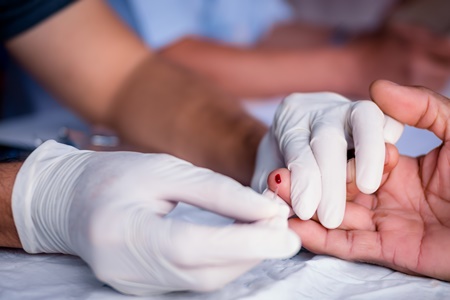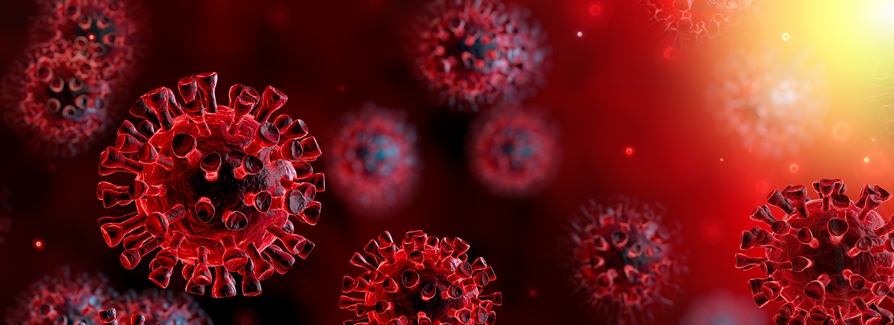Inside This Issue: U.S. HIV testing rates, new funding opportunities, updated fact sheets on RWHAP clients, revisions to opportunistic infections guidelines, COVID-19 booster shots, and Connecting Care podcast.

HIV Testing
U.S. HIV Testing Falls Short of Rates Needed to Achieve EHE Goals
Although annual rates of HIV testing increased during the period from 2014 to 2019, they are still far below the levels needed to achieve the U.S. Ending the HIV Epidemic (EHE) initiative goal of ≥95% of persons with HIV being aware of their infection by 2025, according to a recent CDC study. To evaluate trends in U.S. HIV testing, researchers analyzed testing data for males and nonpregnant females aged 13 years or older with either commercial insurance coverage or Medicaid.
From 2014 through 2019, overall HIV testing in this population group increased an estimated 6% per year among those with commercial insurance, and an estimated 3% among those with Medicaid. However, despite the increase in HIV testing, only 4.0% of persons with commercial insurance and 5.5% of persons with Medicaid received testing for HIV during 2019. The proportion of persons receiving HIV testing was higher among those with Medicaid than among those with commercial insurance across all U.S. geographic regions and all demographic groups, except among persons aged 65 years or older. In 2019, among persons with Medicaid, the percentages of Black persons (8.5%) and Hispanic persons (5.9%) receiving HIV testing were higher than the percentages for White persons (3.9%) and non-Hispanic Asian American persons.
“Based on mathematical modeling studies, these annual testing rates would need to increase at least threefold and be sustained over several years” to achieve the EHE initiative goal of ≥95% of persons with HIV being aware of their infection, according to CDC. “Interventions need to be implemented to increase routine and risk-based HIV testing in clinical settings to higher levels that can help reduce disparities in HIV diagnoses between Black and Hispanic persons compared with non-Hispanic White persons. Increased HIV testing is essential to achieve the goals of the EHE initiative and reduce disparities in HIV diagnoses; public health should partner with health care systems to implement interventions that support increased testing.”
AIDSVu Blog and Infographics Highlight HIV Testing Data and Trends
In the runup to National HIV Testing Day on June 27, AIDSVu published a blog item emphasizing the importance of HIV self-testing, particularly during the COVID-19 pandemic, and summarizing CDC’s new Take Me Home self-testing program. AIDSVu also recently produced a 40 Years of HIV/AIDS in the U.S. timeline, as well as eight infographics focusing specifically on HIV testing:
- HIV Transmission from Undiagnosed Persons
- HIV Self-Testing
- Differences in HIV Testing Across States
- Low HIV Testing Rates in Young People
- Rates of HIV Testing by Race/Ethnicity
- Percentage of Men and Women Ever Tested for HIV
- One in Seven HIV+ Persons Are Unaware of Their Status
- CDC HIV Testing Recommendations

Funding Opportunities
ACF Funding Opportunity: Sexual Health Education for AI/AN Youth
The HHS Administration for Children and Families (ACF) has issued a funding opportunity (HHS-2021-ACF-ACYF-AT-1922) for Native American tribal organizations and governments to develop and implement projects that educate American Indian/Alaska Native (AI/AN) youth on abstinence and contraception for the prevention of pregnancy, sexually transmitted infections, and HIV/AIDS. The target populations for this program are youth 10 to 19 years old, and pregnant and parenting youth under age 21. ACF plans to make eight awards totaling $3.25 million, with individual awards in the range of $350,000 to $600,000. The application deadline is July 26.
NIH Funding Opportunity: Innovative Models for Delivering PrEP and STI Services
The National Institutes of Health (NIH) recently issued a Request for Applications (RFA-AI-20-069) for research to design and evaluate strategies for reducing new HIV cases among people in the U.S. at greatest risk of infection by scaling up pre-exposure prophylaxis (PrEP) and antiretroviral therapy (ART) in sexually transmitted infection (STI) clinical settings. “Projects should make use of CDC surveillance data, AIDSVu, and other sources of state and local HIV/STI epidemiologic data, and the HIV risk profiles of clients of the specific STI clinical setting(s) to identify specific subpopulations at highest risk for HIV acquisition and to discern opportunities to address disparities in access to STI and HIV treatment and prevention services,” according to NIH.
Projects that meet specific milestones for the development of HIV prevention strategies will be eligible to advance to the next phase of the project. In this second phase, “investigators will collaborate with their national, state, and/or local implementation partners to assess the feasibility of their approach and determine whether further optimization is required to ensure its effectiveness.” NIH plans to commit a total of $4 million to fund four to six awards for this project. Application budgets are limited to $400,000 per year in direct costs. The application deadline is October 13.

Affected Populations
HRSA HAB Issues Updated Fact Sheets on RWHAP Clients
The Health Resources and Services Administration’s HIV/AIDS Bureau (HRSA HAB) recently published 10 fact sheets covering specific client population groups who receive care through the Ryan White HIV/AIDS Program (RWHAP). The HRSA HAB fact sheets provide capsule summaries of key data from the 2019 RWHAP Annual Client-Level Data Report, which compiles the latest information on RWHAP client characteristics, retention in care, and viral suppression. The following updated fact sheets are available:
- General Audience Overview: RWHAP Clients
- Transgender Clients
- Female Clients
- Gay, Bisexual, and Other Men Who Have Sex with Men (MSM) Clients
- Hispanic/Latino Clients
- Black/African American Clients
- American Indian/Alaska Native Clients
- Native Hawaiian/Pacific Islander Clients
- Older Adult Clients
- Youth and Young Adult Clients
Guidelines and Recommendations
Revised Opportunistic Infections Guidelines Include Updates on Several Diseases and Immunizations
The U.S. Department of Health and Human Services (HHS) has revised its Guidelines for the Prevention and Treatment of Opportunistic Infections in Adults and Adolescents with HIV (OI Guidelines) to include new information about the management of four infectious diseases – cytomegalovirus (CMV), cryptococcosis, coccidioidomycosis, and bartonellosis – in people with HIV. These updates incorporate the latest available information about the diagnosis and treatment of these infections in particular patient populations, as well as toxicities of certain antiviral medications used to treat CMV. The latest version of the guidelines also includes updates to HHS recommendations concerning immunizations for preventable diseases in adults and adolescents with HIV.

COVID-19 News
CDC and FDA: Booster Shots Not Currently Needed for Fully Vaccinated Persons
“Americans who have been fully vaccinated [for COVID-19] do not need a booster shot at this time,” according to a July 8 joint statement from the CDC and the Food and Drug Administration (FDA). “People who are fully vaccinated are protected from severe disease and death, including from the variants currently circulating in the country, such as Delta.”
CDC and FDA encouraged all Americans who have not yet been vaccinated to get vaccinated as soon as possible to protect themselves and their community, noting that virtually all COVID-19 hospitalizations and deaths are among people who are unvaccinated. “FDA, CDC, and NIH are engaged in a science-based, rigorous process to consider whether or when a booster might be necessary . . . We continue to review any new data as it becomes available and will keep the public informed. We are prepared for booster doses if and when the science demonstrates that they are needed.”
Recent Research Reports in MMWR
Since the beginning of the COVID-19 pandemic, CDC’s Morbidity and Mortality Weekly Report (MMWR) has been providing continuing coverage of COVID-19-related research. CDC is archiving the MMWR reports on a page devoted to studies about COVID-19. For your convenience, we have compiled links to recent MMWR papers below:
- Outcomes Among Patients Referred to Outpatient Rehabilitation Clinics After COVID-19 diagnosis – United States, January 2020-March 2021
- Efficacy of Portable Air Cleaners and Masking for Reducing Indoor Exposure to Simulated Exhaled SARS-CoV-2 Aerosols – United States, 2021
- Use of mRNA COVID-19 Vaccine After Reports of Myocarditis Among Vaccine Recipients: Update from the Advisory Committee on Immunization Practices – United States, June 2021
- Symptoms of Depression, Anxiety, Post-Traumatic Stress Disorder, and Suicidal Ideation Among State, Tribal, Local, and Territorial Public Health Workers During the COVID-19 Pandemic – United States, March-April 2021
- Disparities in Learning Mode Access Among K-12 Students During the COVID-19 Pandemic, by Race/Ethnicity, Geography, and Grade Level – United States, September 2020-April 2021
- COVID-19 Surveillance and Investigations in Workplaces – Seattle and King County, Washington, June 15-November 15, 2020
- COVID-19 Vaccination Coverage Among Adults – United States, December 14, 2020-May 22, 2021
- COVID-19 Vaccination Coverage and Intent Among Adults Aged 18-39 Years – United States, March-May 2021

Educational Resources
Connecting Care Podcast Focuses on Integrated HIV and Opioid Use Services
The HRSA-funded Strengthening Systems of Care for People with HIV and Opioid Use Disorder (SSC) initiative recently launched Connecting Care, a podcast in which clinicians from the Boston Medical Center (BMC) share their experiences on the frontlines of providing integrated HIV and opioid use services. In a series of case studies, BMC HIV and addiction medicine specialists discuss the impacts of HIV and substance use disorder on their patients, as well as systems factors that influence the services they are able to provide for these patients. Recent Connecting Care podcast episodes include:
- Strengthening Methadone Programs: A Harm Reduction Perspective
- Understanding Structural Racism within HIV and OUD Care
- Meeting Clients Where They Are: PrEP on the Frontlines
- Reaching Those Who Need It Most: PrEP for People Who Inject Drugs
- There’s a Pill for That. PrEP for People Who Inject Drugs
- The Intersection of HIV and Opioid Use Disorder in the Time of COVID
SSC is a Special Projects of National Significance (SPNS) initiative that provides coordinated technical assistance across HIV and behavioral health/substance use service providers. The purpose of the SSC initiative is to ensure that people with HIV and opioid use disorder have access to care, treatment, and recovery services that are coordinated, client-centered, and culturally responsive. In addition to hosting the Connecting Care podcast, the SSC website has the following resources, among others:




%202%20-%20small.jpeg)